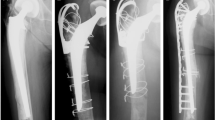Abstract
Ninety-seven patients type II were in this study. There were 35 male and 53 female patient, whose average age at revision was 74,5 year old. In this group the average time to fracture after arthroplasty was 6,2 (1–20) years.
The fracture was spiral in most cases (82%), but some there were transverse (18%). Loosening of the prosthesis often occured with the transverse fracture (p=0,001).
Loosening occured in 30% cases before the femoral fracture : it was rarely a major, but its duration was unknown.
Three different methods of treatment were used in this study:
-
-
conservative treatment was used rarely, where there was a surgical risk in incomplete or undisplaced fracture. Treatment with traction involved a prolonged stay in hospital (two months average).
-
-
internal fixation without removal of the prosthesis was used in 44% cases. Fixation with plates in 93%. Other devices were screw and cerclage wire fixation.
-
-
47,5% cases were revised with a long stem cemented prosthesis.
The most difficult was type II fracture associated with femoral loosening. The location of type II fracture may compromise the stability of prosthesis. Although there was 41% of cases whose prosthesis was not loose before fracture. In these cases, type II fracture has not compromised the stability of prosthesis: the spiral line could shape peri prosthetic mantle of cement.
Healing of the fracture was obtained in most cases (97%). Thus, protetic loosening created by type II fracture has not prevented consolidation: these two events are statistically independant.
The present retrospective study supports the employement of different treatment. Based on these findings, the following management of type II fracture could be recommended:
-
-
undisplaced or incomplete fracture in high risk patients, should be treated conservatively. If loosening of the prosthesis develops, revision of the arthroplasty can be done after fracture healing.
-
-
internal fixation without revision of the prosthesis should be employed if the prosthetic stem stability is not compromised.
-
-
revision of the arthroplasty should be done if loosening of the prosthesis developped before or during the type II fracture occured. Then, a long stem should be employed.
Résumé
La série comportait 97 fractures de type II de Johansson, dont 35 hommes et 53 femmes, d’âge moyen de 75,5 ans. Le délai moyen de survenue de la fracture était de 6,2 ans (1 à 20) après l’arthroplastie. Le trait de fracture était spiroïde dans 82 % des cas, transversal dans 18 %. Un descellement pré existant était observé dans 30 % des cas. Il était observé de façon stastistiquement plus fréquente pour les traits transversaux.
L’étude de la série permet de proposer les indications suivantes :
-
-
stabilité de la prothèse non compromise : ostéosynthèse, par plaque de préférence,
-
-
prothèse instable ou descellée : reconstruction prothétique par un implant à longue queue pontant le foyer de fracture;
-
-
fracture non déplacée ou incomplète chez des patients en mauvais état général : traitement orthopédique. En cas de descellement, celui-ci pourra éventuellement faire l’objet d’un traitement secondaire.
Similar content being viewed by others
Author information
Authors and Affiliations
Additional information
Présenté à la 38ème Réunion S.O.T.EST à Lons-le-Saunier du 17 au 18 juin 1994
Rights and permissions
About this article
Cite this article
de la Caffinière, M., Favreul, E., Kempf, I. et al. Les fractures du fémur de type II après prothèse de hanche. Eur J Orthop Surg Traumatol 5, 184–188 (1995). https://doi.org/10.1007/BF02716508
Received:
Accepted:
Issue Date:
DOI: https://doi.org/10.1007/BF02716508




